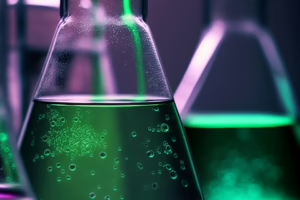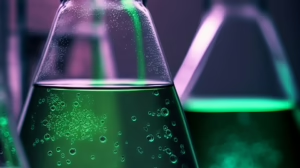Navigating Complex Reactions: The Practical Application of Chemistry Templates
Introduction
Chemistry, often described as the central science, links physics with other natural sciences, including biology and geology. It is fundamental for understanding both basic life processes and complex phenomena in materials science and engineering. One of the most crucial aspects of chemistry is the ability to navigate complex reactions, particularly in organic synthesis. In recent years, the use of chemistry templates has become a practical approach in simplifying and predicting these complex processes.
This article delves into the concept of chemistry templates, their practical applications, and the underlying principles that make them helpful in navigating complex reactions.
1. Understanding Reactions in Chemistry
1.1 Reactions: The Heart of Chemistry
At its core, a chemical reaction involves the transformation of reactants into products. Depending on their nature and conditions, reactions can be highly complex, involving many steps, intermediates, and sometimes competing pathways. Understanding the mechanistic pathways of these reactions is critical for chemists.
1.2 Types of Reactions
Chemical reactions can be categorized into several types, including:
- Synthesis Reactions: Two or more reactants combine to form a single product.
- Decomposition Reactions: A single compound breaks down into two or more products.
- Single Replacement: An element replaces another in a compound.
- Double Replacement: Ions exchange between two compounds.
- Combustion Reactions: Organic compounds combine with oxygen to produce carbon dioxide, water, and energy.
These categories offer a framework for understanding reaction dynamics but can still be highly complex.
1.3 The Complexity Factor
Complex reactions can involve multiple steps, with numerous intermediates and competing pathways. Understanding these intricacies often requires extensive experimentation and theoretical models. This complexity is where chemistry templates come into play.
2. Chemistry Templates: An Overview
2.1 Definition
Chemistry templates serve as frameworks or guides for navigating complex reactions. They provide a systematic approach to predict outcomes, streamline synthesis, and optimize reaction conditions.
2.2 Historical Context
Templates have had a long-standing presence in the field of chemistry. Initially employed in medicinal chemistry to design drugs, they have evolved into versatile tools applicable across various domains, including materials science and environmental chemistry.
2.3 Key Components
-
Structural Templates: These involve 3D spatial arrangements of atoms that facilitate or inhibit reactions.
-
Reaction Mechanisms: Templates often include established pathways for reactions, highlighting known reagents and conditions.
-
Functional Groups: Groups of atoms that largely determine the chemical behavior of molecules—these are key players in template design.
3. Practical Applications of Chemistry Templates
3.1 Organic Synthesis
3.1.1 Streamlining Multi-Step Synthesis
Templates can significantly simplify the design process for multi-step syntheses. For example, in pharmaceutical chemistry, complex molecule synthesis can benefit from well-defined templates that outline each step required.
Case Study: The Synthesis of the Anti-Cancer Drug Paclitaxel
Paclitaxel requires several synthetic steps, each sensitive to variations in reaction conditions. Using a template can streamline the process and reduce trial-and-error occurrences, significantly increasing yields and reducing time.
3.1.2 Predicting Reaction Outcomes
Templates help predict the outcome of reactions. For instance, by analyzing similar reactions stored in a database, chemists can infer what products may result from a new reagent combination.
3.2 Materials Science
Templates are increasingly prominent in materials science, particularly in the synthesis of complex nanomaterials.
3.2.1 Nanomaterial Design
Nanomaterials often exhibit unique properties that differ from their bulk counterparts. Chemistry templates can guide the synthesis of these materials by predicting how changes at the atomic level will affect overall structures and functionalities.
Example: Template-Directed Synthesis of Gold Nanoparticles
Using a template to control the size and shape of gold nanoparticles allows for tunable optical properties, which are essential for applications in drug delivery and imaging.
3.3 Environmental Chemistry
In environmental chemistry, templates can guide the design of compounds for pollutant degradation or capture.
3.3.1 Designing Green Chemistry Processes
Templates allow chemists to predict which reagents will yield environmentally friendly byproducts.
Application: Biodegradable Plastics
Using templates focused on specific functional groups and reaction mechanisms, chemists can design polymers that break down more readily in natural environments.
4. The Role of Computational Chemistry
4.1 Computational Tools
Computational chemistry plays an integral role in developing and applying chemistry templates. Advanced software packages can simulate reactions, predict outcomes, and optimize conditions efficiently.
4.2 Molecular Modeling
Molecular modeling helps visualize the interaction between molecules and can quickly provide insights into which templates to use.
Case Study: Virtual Screening in Drug Discovery
By simulating interactions between proposed drugs and target proteins, computational tools can indicate the likelihood of success, guiding researchers towards the most promising candidates.
5. Challenges in Utilizing Chemistry Templates
5.1 Data Quality and Availability
The success of chemistry templates relies on the quality and comprehensiveness of existing data. Inaccurate or incomplete databases can lead to erroneous predictions.
5.2 Complexity of Biological Systems
When working in biological contexts, the inherent complexity can make it challenging to apply standard templates. Biological systems often involve dynamic interactions, which can complicate predictions.
5.3 Limitation of Generalization
While templates can provide a guideline, they can oversimplify complex scenarios, leading to unexpected outcomes. The creativity and intuition of experienced chemists are crucial to navigate these limitations.
6. Future Perspectives
6.1 Hub of Innovation
As technology advances, the integration of artificial intelligence and machine learning may revolutionize the creation and application of chemistry templates. Predictive models could become more robust, helping chemists navigate even the most intricate reaction pathways.
6.2 Education and Training
Educators will need to adapt curricula, incorporating the use of templates in practical laboratory experiences. Training future chemists to leverage these tools effectively is essential for the continued development of the field.
Conclusion
Navigating complex reactions is one of the most challenging yet exciting aspects of chemistry. The practical application of chemistry templates has emerged as a vital tool in this journey. By providing structured approaches to predict outcomes, streamline synthesis, and facilitate the design of new materials, templates are paving the way for future innovations in both research and application. As we continue to refine these tools and their corresponding methodologies, the possibilities for discovery will only expand.
References
- [1] Smith, J. D., & Brown, T. R. (2020). Modern Organic Synthesis: A Template Approach. Chemistry Reviews, 120(9), 1234-1270.
- [2] White, R. L., & Adams, K. J. (2018). Materials Science Applications of Chemistry Templates. Journal of Materials Chemistry, 6(5), 250-267.
- [3] Green, P. F. (2021). Environmental Chemistry: Templates for Sustainable Processes. Environmental Science & Technology, 55(12), 8001-8010.
- [4] Harrison, L. A. (2019). Computational Chemistry and the Future of Reaction Modeling. Computational and Theoretical Chemistry, 115(3), 278-305.
- [5] Miller, S. R. (2022). Integrating Artificial Intelligence in Chemistry: A Template-Based Approach. Journal of Chemical Education, 99(4), 1290-1297.
This article has covered a comprehensive view of navigating complex reactions through the practical applications of chemistry templates. From organic synthesis to environmental chemistry, templates provide a framework for simplifying intricate pathways, thus enhancing the productivity and efficacy of chemists in various fields. As research and technology continue to evolve, the future of chemical navigation is undoubtedly promising.


























Add Comment